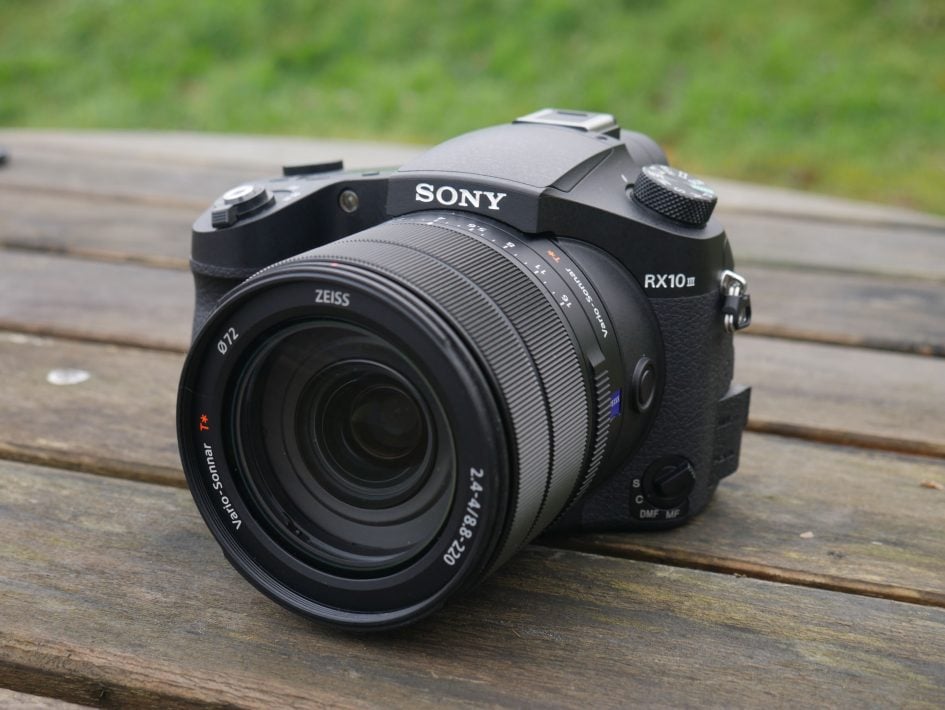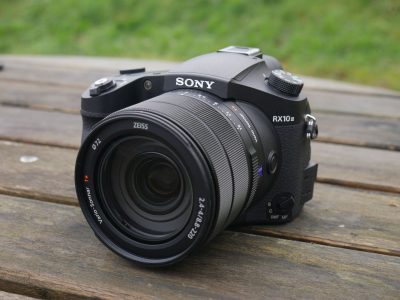Sony Cyber-shot RX10 III review
-
-
Written by Ken McMahon
Verdict
The Sony RX10 III is an update to Sony’s high-end Bridge Super-zoom which retains its predecessor’s 1 inch 20 Megapixel sensor, 4k video, super-slow motion modes, electronic viewfinder and its flip-up 3-inch screen.
What’s new is the lens, which now extends to triple the reach of the earlier RX10 II with an equivalent range of 24-600mm. There’s now a second control ring providing separate controls for both zoom and manual focus on the lens and, as before, a dedicated aperture ring marked with f-stops can be configured for stepped or smooth operation via a switch.
Where the earlier RX10 II featured a constant f2.8 focal ratio though, the new lens has a maximum aperture of f2.4 closing to f4.4 at the telephoto end of the range. And the earlier model’s built in 3-stop ND filter has, sadly in my view, been dispensed with. Slightly improved battery life is the only other update to report, so the RX10 III really is all about the new lens. Read on to see how it compares with Panasonic’s high end bridge super-zoom, the Lumix FZ2000 / FZ2500.

The biggest competition for the RX10 III is the less expensive Lumix FZ2000 / FZ2500. It’s similar in very many respects to the RX10 III, with a 20 Megapixel 1 inch sensor, a slightly bigger electronic viewfinder with the same resolution as the RX10 III, a 3 inch fully articulated touch-screen and a broadly comparable (but not the same) range of video modes with 4K 25p plus Cinema 4K at the top.
But if you’re having trouble deciding between these two models there’s also loads to differentiate them, starting with their respective lenses. The Sony has a 25x zoom starting at the same 24mm wide angle as the FZ2000 / FZ2500, but extending a bit further to 600mm equivalent compared with 480mm. It’ll get you just that bit closer in to distant subjects. The Sony lens is also a little bit brighter at f2.4-4 compared with f2.8-4.5 on the Lumix.
One other important difference is that the Lumix FZ2000 / FZ2500 lens now incorporates a pair of neutral density filters allowing you to reduce the amount of light it transmits by up to 64x in 2 stop increments. Interestingly, though the earlier RX10 II had a built-in 3x ND filter it’s been dropped on the latest Mark III. One thing in the RX10 III’s favour though is that its lens has a smallest aperture setting of f16 compared with f8 on the FZ2000 / FZ2500, what’s more, the Sony lens has a dedicated aperture ring which can be configured for stepped or smooth operation.
The screens are the same size and similar resolution, but the RX10 III’s screen can only tilt up or downwards whereas the FZ2000 / FZ2500’s panel is side hinged and can face in any direction including forwards which can be invaluable for video recording. More importantly, the Lumix FZ2000 / FZ2500’s screen is now touch sensitive, allowing setting of the AF area with a tap, silent control of movie exposure and much more.
Which brings us neatly on to video. For anyone buying either of these cameras their video capabilities are like to be at least as important as their photo features so how do they compare? In terms of modes both offer 4K video but the FZ2000 / FZ2500 gives you more options with 4K UHD at 24, 25 or 30p or the wider Cinema 4K mode at 24p. Then there’s a huge raft of 1080 HD modes at bit rates up to 200mb/s. The RX10 III lacks Cinema 4k, only offering 4k in UHD. But the Sony makes up for it in slow-motion. Where the Lumix FZ2000 / FZ2500 offers a selection of variable frame rate options up to 120fps for a 4x slowdown, the RX10 III’s HFR modes go way beyond that with a fastest frame rate of 960 / 1000fps offering a 40x slow down.
Both models provide full PASM exposure control for movie recording, and exposure can be adjusted silently during recording using the FZ2000 / FZ2500’s touch-screen (which can also be used to adjust focus) or with the RX10 III’s stepless aperture ring. The new zoom buttons and the internal structure of the FZ2000 / FZ2500’s zoom provide better control of zooming for slower, smoother, and steadier results.
Both models are fairly evenly matched for continuous shooting speeds using their mechanical shutters, but the FZ2000 / FZ2500 cleverly exploits its sensor to deliver 4K photo modes offering not just 30fps continuous shooting at 8 Megapixel resolution, but post-focus and focus stacking modes.
Both models feature built-in Wifi and the Sony also has NFC so you can tap it with an NFC-equipped android phone for a quick connection. Other than that both offer quite similar Wifi features in terms of remote control and image transfer, though you can extend the RX10’s capabilities with downloadable apps. Battery life is significantly better on the RX10 III and you can charge the RX10 III battery in the camera over USB. Both camera’s offer a high degree of customisation, but the FZ2000 / FZ2500’s touch screen gives it and edge with programmable touch buttons in addition to the physical ones.
Depending on where you shop, the Sony RX10 III is around 30 percent more expensive than the Lumix FZ2000 / FZ2500. For many people that will be enough to swing it in the FZ2000 / FZ2500’s favour, given that these two models are closely matched in many respects and the Lumix FZ2000 / FZ2500 is ahead in some areas, namely a wider selection of movie modes, fully articulated touch screen, slightly bigger viewfinder, better continuous shooting and better zoom control on the lens. The thing that pulls you back to the RX10 III is the lens, not just the longer range but the quality which outperformed the Lumix FZ2000 / FZ2500 in my tests. The Sony is also officially weather-sealed and supports more professional audio connectivity accessories.
Ultimately the RX10 III really is all about the lens, that, after all, is the only major thing that sets it apart from the earlier RX10 II. There’s no doubt that having the extra reach at the telephoto end can be really useful, particularly for sports and wildlife photography. But just as important is the quality and the RX10 III’s zoom delivers superb results throughout its 25x range.
Beyond that, there’s a second control ring and slightly improved battery life plus of course all the features that made the RX10 II a success including an excellent high resolution EVF, 4K UHD video, High frame rate movie recording, pro audio connectivity, fast continuous shooting, great wifi features with NFC and downloadable apps and not forgetting metal-bodied weather-sealed construction.
About the only thing the RX10 III lacks is a touch screen – one of the key areas where it loses out to the Lumix FZ2000 / FZ2500. The Lumix offers better value for money and could prove a better buy for those on a tight budget. In the same way, the earlier RX10 II will appeal if you can live without the extra zoom reach. That said, many will consider the extra reach and superb quality of the RX10 III’s lens well worth the extra.
Check prices at Amazon, B&H, Adorama, eBay or Wex. Alternatively get yourself a copy of my In Camera book, an official Cameralabs T-shirt or mug, or treat me to a coffee! Thanks!




